| Reviews & Columns |
|
Reviews DVD TV on DVD Blu-ray 4K UHD International DVDs In Theaters Reviews by Studio Video Games Features Collector Series DVDs Easter Egg Database Interviews DVD Talk Radio Feature Articles Columns Anime Talk DVD Savant Horror DVDs The M.O.D. Squad Art House HD Talk Silent DVD
|
DVD Talk Forum |
|
|
| Resources |
|
DVD Price Search Customer Service #'s RCE Info Links |
|
Columns
|
|
|
Masterworks of American Avant-garde Experimental Film 1920-1970
Flicker Alley // Unrated // October 6, 2015
List Price: $59.95 [Buy now and save at Amazon]
The Movies:
Though I can't remember a time when I wasn't interested in movies, it wasn't until I was leaving high school and starting college that I really got into film. When I discovered that there was more than the Hollywood fare offered at the local multiplex I dove into seeing as many art films as I could, and between screenings I'd read up on movies. I soon stumbled upon references to 'avant-garde' movies, but they were nearly impossible to find back in the VHS days. Sure, the books and articles would describe the movies, but these descriptions did not come close to the real thing and were often hard to understand. What does "a visual representation of sound" look like? I eventually tracked down and was able to see the major avant-garde films but even today it is hard to find these films. Sure, Image put out a great collection in 2005, Unseen Cinema - Early American Avant-Garde Film 1894-1941 (reviewed here) but that set is long out-of-print and vendors are asking hundreds of dollars for it. The same goes for Kino's two volumes of avant-garde films (Avant-Garde and Avant-Garde 2). The only easily available collection of innovative cinema that's still in print is the excellent Treasures IV: American Avant-Garde Film, 1947-1986 (reviewed here). That is until now. Flicker Alley in association with the Blackhawk Films Collection has just released Masterworks of American Avant-Garde Experimental Film, 1920-1970, a bravura collection of 36 experimental films that run a total of nearly seven hours. It's a collection that will thrill fans of unusual and non-narrative film.
The set begins with Manhatta (1920), a collaboration between still photographer Paul Strand and painter Charles Sheeler, and both artists bring their eye for composition and detail to this film. This early look at Manhattan started the 'city symphony' genre films that was popular in the silent era, and it is easy to see why this picture was so influential. Often poetic in the way it was filmed, these two artists turn dull everyday scenes into something beautiful. From a mass of people getting off of a ferry to smoke emerging from the chimneys of tenement houses, this film makes you see the routine in a new light.
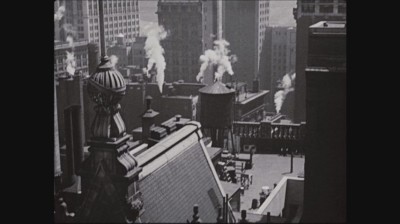
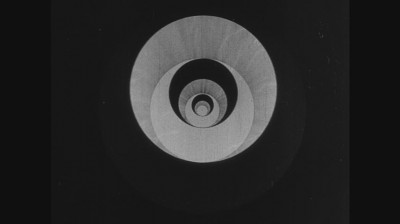
Artist Marcel Duchamp (most famous for his painting Nude Descending a Staircase No.2) created the film Anémic Cinéma (1924) under his pseudonym Rrose Sélavy. Its unique images of spinning patterns and spiraled text (in French... unfortunately there is not an option for subtitles) are mesmerizing to watch. Though it's a bit of a one-trick-pony, the film is still interesting.
Another great film is The Life and Death of 9413 - A Hollywood Extra (1927). This German Expressionist-influenced film mixes miniature shots with live action scenes to great effect. It is a comment on the Hollywood system that uses people without remorse and is a personal favorite.
Many of the films included on this set strive to show everyday scenes or objects in a new light. This is the case with Ralph Steiner's Mechanical Principles (1930) that consists of close-up images of machines working. There's a beauty in the motion and in the engineering of these gears and pistons and the film is quite entrancing.
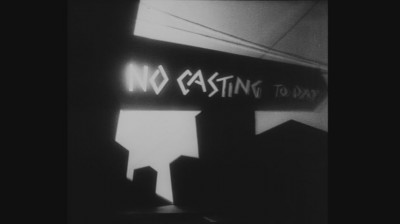
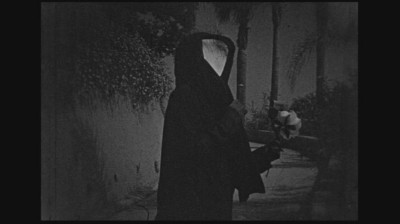
While I enjoy those types of movies, the avant-garde films that really get me excited are the ones that tell a story... or do they? There are several movies that seem to have a narrative hidden behind the fast editing and unusual visual effects, but on first viewing it's just out of grasp. One of the best, and most famous, in this sub-genre is Meshes in the Afternoon (1943). Created by the husband and wife team of Maya Deren and Alexandr Hackenschmied, this 14-minute (with no soundtrack, as was intended when they made it) features reoccurring images and motifs and stark camera angles. When taken together, this surreal film shows a world where it's hard to say what is real, or if anything is. This is one of those films that as soon as it's done playing, you'll want to chapter-skip back to the beginning and watch it again.
A very unique film in this collection of unique films is An Optical Poem by Oskar Fischinger. A wonderfully animated piece, a series of circles interprets Liszt's Hungarian Rhapsody visually. It's a very colorful and dynamic piece, but the reason it stands out in this set is that Fischinger made it when he was working at MGM and it was released theatrically as a short. (Fischinger would later go on to design the Toccata and Fugue sequence for Fantasia but removed his name when his images were changed.)
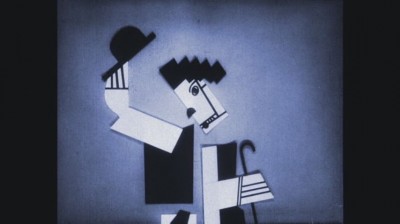
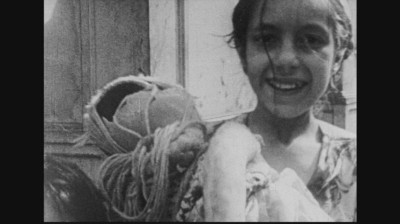
Another highlight is N.Y. N.Y. (1958). Like Manhatta that starts off this collection, this is an ode to New York City, but one that captures the vibrant metropolis over 35 years later. Director Francis Thompson used a special camera that employed mirrors and prisms to capture the city. With overlaying images and visual distortion he makes an interesting film the shows New York like never before.
This set is filled with interesting, unusual films. Kenneth Anger's Eaus d'artifice is a must-see, as is In the Street (1948) a look at children in the streets of Spanish Harlem. Digging into this collection you'll find works that amazing and confound, and while not all of them totally work and a few can drag a bit, they are all remarkable.
This collection arrives on both Blu-ray and DVD, two discs of each. They are housed in a double-width quadcase with a nice booklet.
Video:
These films look great in high definition. That's not to say they're perfect, but they look as good as they will likely ever look. Manhatta and Ballet Mechanique are both from 2K restorations, and all of the rest are from good prints. There are some scratches and dirt, and many of these were filmed in 16mm so the image isn't as sharp, but Flicker Alley has done a good job of searching out quality prints.
Audio:
The sound is also excellent. The pre-sound films have new scores by a variety of very good musicians including Rodney Saur, Donald Sosin, and Eric Beheim.
Extras:
There are a few very nice films included as extras in this set: Sappho and Jerry, Parts 1-3 by Bruce Posner, Ch'an by Francis Lee, and Seasons by Stan Brakhage and Phil Solomon. These are a bit later than the scope of the collection, but they're very welcome additions.
The 28-page booklet that's included has an essay by Bruce Posner along with credits and notes about each film as well as biographies of the filmmakers. It has some great information and is a great bonus.
Final Thoughts:
These experiments captured on celluloid are great for those who are looking for a little more challenge when watching a movie and who want to see the art of filmmaking taken to the next level. Flicker Alley has put out another remarkable set. Highly Recommended.
Though I can't remember a time when I wasn't interested in movies, it wasn't until I was leaving high school and starting college that I really got into film. When I discovered that there was more than the Hollywood fare offered at the local multiplex I dove into seeing as many art films as I could, and between screenings I'd read up on movies. I soon stumbled upon references to 'avant-garde' movies, but they were nearly impossible to find back in the VHS days. Sure, the books and articles would describe the movies, but these descriptions did not come close to the real thing and were often hard to understand. What does "a visual representation of sound" look like? I eventually tracked down and was able to see the major avant-garde films but even today it is hard to find these films. Sure, Image put out a great collection in 2005, Unseen Cinema - Early American Avant-Garde Film 1894-1941 (reviewed here) but that set is long out-of-print and vendors are asking hundreds of dollars for it. The same goes for Kino's two volumes of avant-garde films (Avant-Garde and Avant-Garde 2). The only easily available collection of innovative cinema that's still in print is the excellent Treasures IV: American Avant-Garde Film, 1947-1986 (reviewed here). That is until now. Flicker Alley in association with the Blackhawk Films Collection has just released Masterworks of American Avant-Garde Experimental Film, 1920-1970, a bravura collection of 36 experimental films that run a total of nearly seven hours. It's a collection that will thrill fans of unusual and non-narrative film.
The set begins with Manhatta (1920), a collaboration between still photographer Paul Strand and painter Charles Sheeler, and both artists bring their eye for composition and detail to this film. This early look at Manhattan started the 'city symphony' genre films that was popular in the silent era, and it is easy to see why this picture was so influential. Often poetic in the way it was filmed, these two artists turn dull everyday scenes into something beautiful. From a mass of people getting off of a ferry to smoke emerging from the chimneys of tenement houses, this film makes you see the routine in a new light.


Artist Marcel Duchamp (most famous for his painting Nude Descending a Staircase No.2) created the film Anémic Cinéma (1924) under his pseudonym Rrose Sélavy. Its unique images of spinning patterns and spiraled text (in French... unfortunately there is not an option for subtitles) are mesmerizing to watch. Though it's a bit of a one-trick-pony, the film is still interesting.
Another great film is The Life and Death of 9413 - A Hollywood Extra (1927). This German Expressionist-influenced film mixes miniature shots with live action scenes to great effect. It is a comment on the Hollywood system that uses people without remorse and is a personal favorite.
Many of the films included on this set strive to show everyday scenes or objects in a new light. This is the case with Ralph Steiner's Mechanical Principles (1930) that consists of close-up images of machines working. There's a beauty in the motion and in the engineering of these gears and pistons and the film is quite entrancing.


While I enjoy those types of movies, the avant-garde films that really get me excited are the ones that tell a story... or do they? There are several movies that seem to have a narrative hidden behind the fast editing and unusual visual effects, but on first viewing it's just out of grasp. One of the best, and most famous, in this sub-genre is Meshes in the Afternoon (1943). Created by the husband and wife team of Maya Deren and Alexandr Hackenschmied, this 14-minute (with no soundtrack, as was intended when they made it) features reoccurring images and motifs and stark camera angles. When taken together, this surreal film shows a world where it's hard to say what is real, or if anything is. This is one of those films that as soon as it's done playing, you'll want to chapter-skip back to the beginning and watch it again.
A very unique film in this collection of unique films is An Optical Poem by Oskar Fischinger. A wonderfully animated piece, a series of circles interprets Liszt's Hungarian Rhapsody visually. It's a very colorful and dynamic piece, but the reason it stands out in this set is that Fischinger made it when he was working at MGM and it was released theatrically as a short. (Fischinger would later go on to design the Toccata and Fugue sequence for Fantasia but removed his name when his images were changed.)


Another highlight is N.Y. N.Y. (1958). Like Manhatta that starts off this collection, this is an ode to New York City, but one that captures the vibrant metropolis over 35 years later. Director Francis Thompson used a special camera that employed mirrors and prisms to capture the city. With overlaying images and visual distortion he makes an interesting film the shows New York like never before.
This set is filled with interesting, unusual films. Kenneth Anger's Eaus d'artifice is a must-see, as is In the Street (1948) a look at children in the streets of Spanish Harlem. Digging into this collection you'll find works that amazing and confound, and while not all of them totally work and a few can drag a bit, they are all remarkable.
The Combo Pack:
This collection arrives on both Blu-ray and DVD, two discs of each. They are housed in a double-width quadcase with a nice booklet.
Video:
These films look great in high definition. That's not to say they're perfect, but they look as good as they will likely ever look. Manhatta and Ballet Mechanique are both from 2K restorations, and all of the rest are from good prints. There are some scratches and dirt, and many of these were filmed in 16mm so the image isn't as sharp, but Flicker Alley has done a good job of searching out quality prints.
Audio:
The sound is also excellent. The pre-sound films have new scores by a variety of very good musicians including Rodney Saur, Donald Sosin, and Eric Beheim.
Extras:
There are a few very nice films included as extras in this set: Sappho and Jerry, Parts 1-3 by Bruce Posner, Ch'an by Francis Lee, and Seasons by Stan Brakhage and Phil Solomon. These are a bit later than the scope of the collection, but they're very welcome additions.
The 28-page booklet that's included has an essay by Bruce Posner along with credits and notes about each film as well as biographies of the filmmakers. It has some great information and is a great bonus.
Final Thoughts:
These experiments captured on celluloid are great for those who are looking for a little more challenge when watching a movie and who want to see the art of filmmaking taken to the next level. Flicker Alley has put out another remarkable set. Highly Recommended.
|
| Popular Reviews |
| Sponsored Links |
|
|
| Sponsored Links |
|
|
| Release List | Reviews | Shop | Newsletter | Forum | DVD Giveaways | Blu-Ray | Advertise |
|
Copyright 2024 DVDTalk.com All Rights Reserved. Legal Info, Privacy Policy, Terms of Use,
Manage Preferences,
Your Privacy Choices | |||||||













